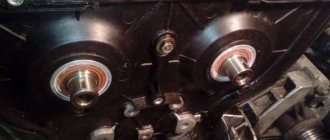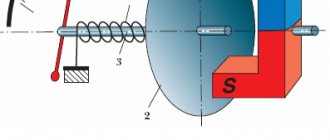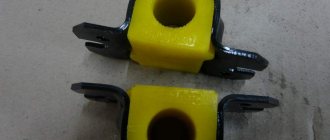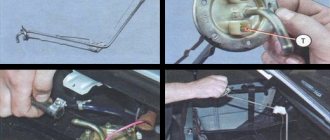The gearbox of almost any modern car has oil seals for the input shaft, right and left CV joints. Their number may vary depending on whether the car is equipped with rear- or front-wheel drive. This part is needed to prevent oil leakage directly from the gearbox housing. The oil seal is a consumable item, so the gearbox oil seal often needs to be replaced. Another function that puts additional stress on this element is protection against dust and dirt getting inside.
It is impossible to give a definite answer to the question of exactly how much the presented work costs; the price is determined by many factors, including depending on what type of oil seal needs to be replaced (input shaft, right or left CV joint). High-quality repair of a manual transmission usually does not take more than a day (if you change the input shaft oil seal) or may even take 4-5 hours.
- Where is the gearbox seal located?
- Transmission seal replacement process
- Important nuances when replacing the gearbox seal
Where is the gearbox seal located?
The gearbox oil seal is located in the clutch housing on the inside of the box, and therefore its replacement is possible only after disconnecting the housing. To carry out the work of replacing the oil seal, you will need an inspection pit or overpass. Before starting work, reliable stops are placed under the wheels of a car standing on a pit or overpass to prevent its accidental movement.
Materials for replacing the gearbox seal
- keys for “10”, “13”.
- a curved slotted screwdriver or something similar to a crochet hook.
- awl.
- plastic pipe from under water.
For such repairs you will need an inspection hole or overpass. Important! When you go into a hole, be sure to immobilize the vehicle using the parking brake and chocks.
Transmission seal replacement process
If the oil seal has become unusable, it cannot be restored or repaired; it must be immediately replaced with a new part. The most common reasons that the oil seal stops performing its functions correctly are:
— wear and tear from long service life;
— mechanical damage from impact;
- deformation.
In these situations, the only correct solution is to replace the gearbox seal. The quality of the work performed will largely determine how long the gearbox itself will work from defects. These works are often carried out in conjunction with replacing the CV joint. The initial stage of work is diagnosing the condition of the gearbox; usually (in this case it all depends on the make of the car) its repair becomes necessary after 70 thousand kilometers. The cost of work and the speed of troubleshooting will largely depend on timely contact with specialists.
Before repairing the gearbox, the drive shafts are removed and the internal elements of the CV joint are dismantled. This is a necessary procedure in order to gain direct access to the seal. Before installing a new element, it must be treated with grease. The oil seal is mounted in its place under the influence of a special tool - a mandrel.
We recommend: How do valves work in an engine?
1. Place the car on a lift.
2. Disconnect the wire from the terminal.
3. Remove the flywheel.
4. Remove the rear shield of the clutch housing, which is directed towards the bushings.
5. Unscrew the bolts (8 pieces).
6. Remove the holder from the part.
7. Now you need to knock it out of the gearbox; to do this, use a screw and a hammer.
8. Now we take the new element and press it into the holder. Outer diameter -99(±0.5) mm.
9. The working edge should be on the inside, if so, turn it over.
10. A gasket that is torn must be removed. It will stay in place thanks to the grease on the holder.
11. Lubricate the edge with engine oil.
12. Also lubricate the crankshaft flange with engine oil.
13. Place the working edge onto the flange.
14. Tighten the bolts.
15. Reinsert the crankcase and bushings.
16. Replace the flywheel and clutch.
Done, the gearbox seal has been successfully replaced. Let your car drive for a long time and not leak. A good owner's car is always in excellent condition. So it all depends on you! Monitor and check, take it for diagnostics on time if necessary. And try not to waste a lot of money on service centers, but also don’t try to do everything yourself if you don’t understand this area.
Important nuances when replacing the gearbox seal
1. To replace the seals of the internal joints of the front wheel drive, drain the oil from the gearbox.
2. The front wheel drive inner joint seals can be replaced without removing the gearbox from the vehicle.
3. Do not disconnect both front wheel drives at the same time, as the side gears will move inside the differential box and reinstallation of the drives will become impossible.
Subscribe to our feeds on social networks such as Facebook, Vkontakte, Instagram, Pinterest, Yandex Zen, Twitter and Telegram: all the most interesting automotive events collected in one place.
Gearbox seal VAZ 2107 - description and purpose
An oil seal is a special seal in a vehicle that is necessary to seal gaps and cracks. For example, in a gearbox, the oil seal plays a vital role - it is fixed at the junction between the moving and stationary mechanisms, preventing oil from leaking out of the gearbox.
The oil seals in the VAZ 2107 gearbox are not made of rubber, as most drivers believe. In fact, this product is constantly in the transmission oil, and to keep production to a minimum, manufacturers make oil seals from CSP and NBR composite materials. At the same time, the gasket feels equally “good” at any temperature - from -45 to +130 degrees Celsius.
Factory equipment of the VAZ 2107 gearbox
Box seal dimensions
The gearbox itself on the “seven” is designed for many years of service. However, the service life of the device directly depends on how often (and in a timely manner) the driver changes the seals. Indeed, during the operation of the machine, it is the oil seals and sealing joints that are the first to fail (tear, wear out, squeeze out). Therefore, timely replacement of the oil seal will help prevent expensive repairs of other gearbox mechanisms.
For proper replacement, you need to know the dimensions of the VAZ 2107 gearbox seals:
- The input shaft seals have a weight of 0.020 kg and dimensions of 28.0x47.0x8.0 mm.
- The secondary shaft seals weigh a little more - 0.028 kg and have the following dimensions - 55x55x10 mm.
Products are made to the strict standards of the modern rubber industry
Which ones are better
The main question for any VAZ 2107 driver when repairing the gearbox is: which oil seal is best to put on the shafts to avoid rapid wear? In fact, there is no universal option.
The standard equipment of the shafts involves the use of Vologda oil seals, but if necessary, you can install any others, even imported ones.
Industry leaders can be considered:
- OJSC "BalakovoRezinoTekhnika" (main materials of manufacture - composites and alloys);
- (the main manufacturing material is thermoplastic elastomers);
- (made from rubber compounds with various additives).
The most affordable oil seal for a box shaft costs 90 rubles; the more modern the manufacturing technology, the more expensive the product will be valued.
Photo gallery: selection of the best oil seals for the VAZ 2107 gearbox
Affordable and high-quality gearbox seals
The most modern oil seals, which are used today to equip premium foreign cars
BRT oil seals are distinguished by low prices and widespread use in all regions of the country
Replacing the automatic transmission torque converter oil seal with your own hands
A leaking automatic transmission torque converter oil seal is a car owner’s worst nightmare. Moreover, you may not even suspect that it is leaking until you see marks on the asphalt after the car has been parked for a long time. Well, if it gives a strong leak, then you can contact the service center immediately. And, if it simply leaks, then oil starvation in the box will lead to rapid wear of the rubbing parts.
But before we talk about repairing the donut, let's look at how it works.
Signs of oil seal destruction
The seals are located directly on the shafts inside the box, so their wear can be visually determined only when disassembling the gearbox. However, any driver can quickly detect oil seal damage by eye, because there are obvious symptoms:
- Transmission oil leaks under the car.
- Constantly low oil level in the box.
- Problems with shifting gears while driving.
- Crunching and grinding in the gearbox when changing gears.
There are plenty of options. If there is an oil leak at the junction of the clutch bell and the engine, then it could be either the engine crankshaft rear oil seal or the gearbox input shaft oil seal. If there is a leak at the junction of the clutch bell and the gearbox body, the gasket is kaput. If it is wet at the rear end of the box - the gasket or oil seal of the secondary shaft
Electrician
https://www.vaz04.ru/forum/10–4458–1
It would seem how the performance of such a complex unit as a gearbox can depend on a small part. However, loss of tightness for the box is fraught with big problems, because even minor losses of transmission oil will immediately affect the lubrication of moving elements.
Oil leaks under the gearbox are the first and most obvious sign of oil seal failure.
It is recommended to change the oil seals in the VAZ 2107 box every 60 - 80 thousand kilometers. The replacement is associated with an oil change, so it will be convenient for the driver to perform these works at the same time. Before this period, it is necessary to change the oil seal only when there are clear signs of its destruction.
Causes of manual transmission oil seal malfunction
If there are obvious signs of oil leakage on the gearbox, then the oil seal has stopped performing its functions. Frequent causes of malfunction:
- Natural wear and tear over a long service life. Nowadays, manufacturers care about the durability of parts, but sooner or later even the most durable materials become unusable. If we talk about seals, then under the influence of high temperatures and oil, rubber cracks and dries out;
- Mechanical damage is often associated with road traffic accidents or poor quality repairs;
- Deformation;
- Use of non-original oil seals made from low quality materials.
We recommend: How to properly check the oil (fluid) level in an automatic transmission?
To replace the old seal with a new one, you need to understand the causes of the failure. If the reasons are not found and corrected, there is a high probability that the new part will also quickly break.
Input shaft oil seal
The input shaft oil seal is located directly on part of the input shaft and is in contact with the clutch housing. Therefore, to replace this product, you will need to remove the casing.
To work you will need to prepare:
- nut heads;
- hammer;
- puller;
- flat screwdriver;
- knife (they are most convenient for removing the old gasket);
- new oil seal;
- transmission oil;
- new input shaft seal.
The oil seal acts as a connecting gasket between the shaft and the clutch mechanisms
The procedure for replacing the seal can be carried out either on the removed box or directly on the car. However, it is easier and faster to change the product on a dismantled gearbox:
- Disconnect the gear shift fork from the box.
- Remove the release bearing by clamping it with a puller.
- Unscrew the six nuts securing the clutch housing.
- Remove the casing from the box.
- Use the tip of a knife or screwdriver to pry up the old oil seal on the input shaft and remove it.
- It is good to clean the landing area so that there are no traces of the seal, spraying or oil leaks.
- Install a new oil seal, having previously lubricated it with transmission oil.
- Next, assemble the box in reverse order.
Video: replacement instructions
Comments from car owners about replacing gearbox seals
Need advice on replacing the seal on a manual transmission...
There is a leak on the left side of the manual transmission, where the three gear shift levers enter into it.
The box is located in a niche, it is difficult to get there... The question is, how to do this? Should I hang the box or ask a girl with thin hands to help?
You need to unscrew the rear gearbox bracket and lower it as low as possible. Then unscrew the lever bolt and carefully remove the lever. There is a rubber ring inserted at the very edge of the box opening. Take it out, pick up another one, for example, I have from a universal set, insert it into the groove. Carefully insert the lever into the same position, in advance with the bolt, to catch the threads of the clutch fork inside the gearbox.
The driveshaft does not need to be unscrewed; at most, the outboard shaft can be removed. The muffler will need to be disconnected, most likely. Here you need to look at availability. Great if there is a lot of space.
Everything... changed...)) Regarding unscrewing the outboard - it depends on the specific car, it’s different for everyone. I had to twist it. I changed it in the garage in a pit. Unscrewed 6 bolts and nuts of the elastic coupling. I unscrewed the 4 bolts securing the silencer, removed the fastenings from 4 rubber bands (and for some reason my silencer consists of only 2 parts). It was not very convenient to remove the silencer. It is better to first remove one fastening in the middle, then both fastenings of the rear can, supporting the can with a jack, and then the last fastening in the middle of the car. After this, 6 bolts for fastening the thermal protection, using the same wrench, 2 bolts for the outboard bearing. I pulled the cardan aside and it came out of the tail of the box.
Next, the wrench is 30, but you need a very deep socket, because a long rod sticks out of the nut. The standard one didn't fit. Or move the carob. The secondary shaft flange is jammed with a large bolt. I drained the oil by unscrewing the drain plug from the bottom with a 17 hexagon socket (for some reason, 17, although the manual says 19. I first bought it with a 19, then I had to go change it). The filler on the side is also 17. I unscrewed the nut, pulled off the secondary shaft flange, and there was the oil seal. The seal had to be torn out; it was a bit tight. The new one also had to be hammered in, but lightly and through a piece of wood. The whole procedure with analysis takes about 2 hours, but this takes into account the fact that 50% of the time it took me personally to unscrew the 4 bolts of the silencer at the junction of the knees. As a result, I had to saw the bolts. Therefore, if there is no particular need to film the second half, it’s better not to!! )))) All nuts and bolts are quite accessible and can be unscrewed normally. Along the way, I discovered two holes in the silencer and removed the gear shift rod joint, since there was excellent access. Now I'm looking for how to eliminate the play in the hinge.
It is not necessary to remove the box to replace the seals. You need to remove the drives, pull them out, pry the seal with a screwdriver and pull it out, then clean the hole. Then take the sealant, lubricate the new element and carefully press it into the hole (tapping it slowly with something).
I don’t know about you, but, for example, on a figure eight, the oil seals of the right and left drives differ in the direction of the oil drain notches: on the right, the arrow points clockwise, on the left, counterclockwise.
You only need to install the original element. The non-original one lasted me a week.
We recommend
It depends on which seal: rear or front. If it is rear, then a wrench is not needed, since the nut is splined. A light chipper (you can use a flat screwdriver instead) to pry out the deformed part (driven into the slots), and then a flat screwdriver to turn the nut and unscrew the shank. In this case, it is advisable to change the spline nut as well. If you need to change the front element, then there should be, like, a 17th socket wrench under the clutch housing. 8 bolts if I counted correctly.
Source
Secondary shaft oil seal
This gasket is located on the secondary shaft and disconnects it from the box flange. In this regard, replacing the secondary shaft oil seal proceeds according to a different scheme and is very different from working on the primary shaft.
To replace you will need:
- spanners;
- screwdriver with a flat thin blade;
- puller;
- pliers;
- transmission oil.
The oil seal seals the gap between the output shaft and the flange
The work progresses according to the following algorithm on the removed gearbox:
- Firmly fix the box flange so that it does not move.
- Turn the nut securing it with a wrench.
- Using a screwdriver, carefully pry up the metal ring and pull it out from the secondary shaft.
- Place the puller against the end of the shaft.
- Press out the flange together with the fixing washer.
- Use pliers to grab the old oil seal.
- Clean the seating area and install a new oil seal.
- Next, assemble the structure in reverse order.
Types and purpose of oil seals
Essentially, an oil seal is an O-ring. For its manufacture, fluorine rubber or silicone are used, which can withstand heat and temperature changes, and are also resistant to the negative effects of motor oil.
Based on their location, there are 2 types of oil seals:
- Rear. Larger and more wear-resistant. If it was made with high quality, it can last a very long time - especially if the engine is properly cared for.
- Front. It differs from the front one in its smaller size and in that it wears out more intensively. Before you start replacing it, you should find out exactly which of the seals has failed.
Purpose of oil seals
The motor is equipped with a lubrication system that supplies oil to all working mechanisms. The peculiarity of the crankshaft is that its housing is brought out, so lubricant leaks at the exit points. It is at this point that the oil seal is installed, the diameter of which fully corresponds to the diameter of the crankshaft.
In vehicles with rear-wheel drive and longitudinally mounted engines, the seals are located in the crankshaft shield in front of the support bearing. In engines that do not have shields (front-wheel drive cars with longitudinally mounted engines and timing belts), the oil seals are installed in the cylinder block.
If the seal is faulty, lubricant leaks.











